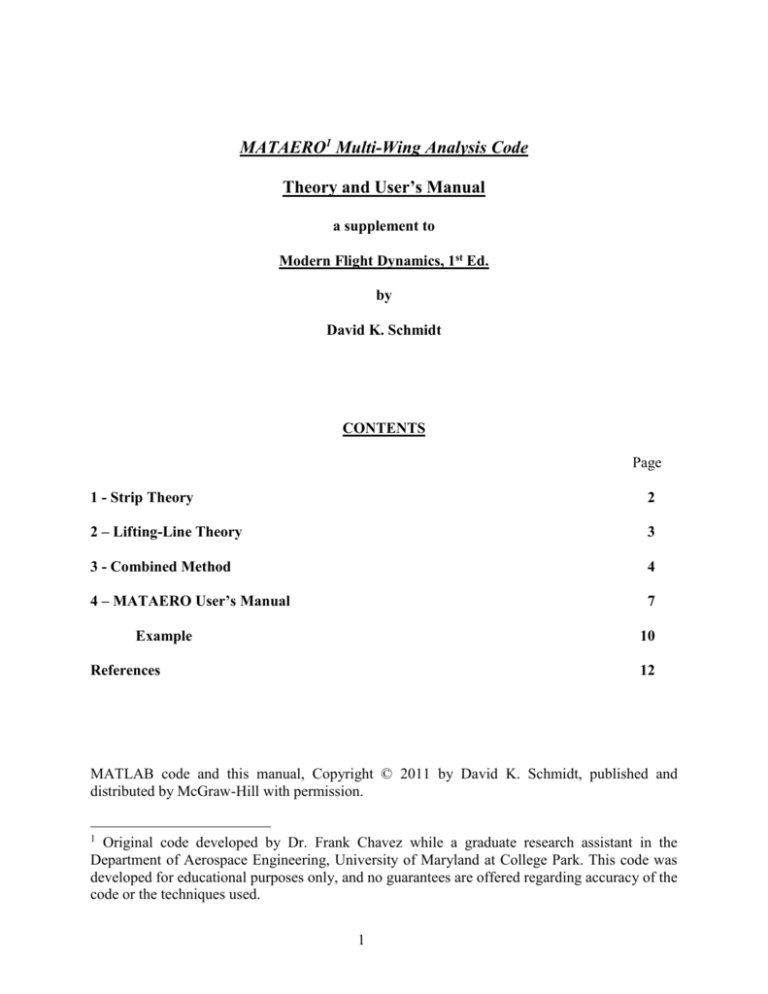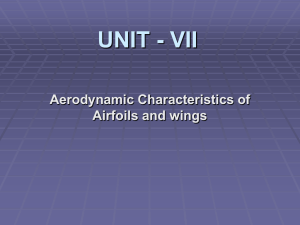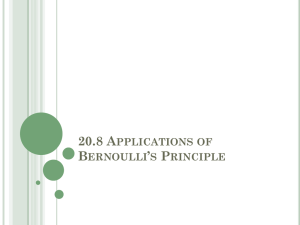MATAERO_Users_Guide - McGraw Hill Higher Education
advertisement

MATAERO1 Multi-Wing Analysis Code Theory and User’s Manual a supplement to Modern Flight Dynamics, 1st Ed. by David K. Schmidt CONTENTS Page 1 - Strip Theory 2 2 – Lifting-Line Theory 3 3 - Combined Method 4 4 – MATAERO User’s Manual 7 Example 10 References 12 MATLAB code and this manual, Copyright © 2011 by David K. Schmidt, published and distributed by McGraw-Hill with permission. 1 Original code developed by Dr. Frank Chavez while a graduate research assistant in the Department of Aerospace Engineering, University of Maryland at College Park. This code was developed for educational purposes only, and no guarantees are offered regarding accuracy of the code or the techniques used. 1 In this manual we will discuss a MATLAB computer code MATAERO, which is available at www.mhhe.com/schmidt, developed to compute the total lift and moment coefficients for an individual 3-D wing, as well as for several wings in close proximity. The method assumes nonlinear, 2-dimensional airfoil section data is available a priori. This code then calculates the lift and moment coefficients, including wing interference effects. The method employs an iterative scheme in which the circulation distribution, and hence the lift distribution, is adjusted until it satisfies a global interference condition. The method is simple, and is based on two well known aerodynamic theories, strip theory and lifting line theory. A brief review of each of these theories is given, followed by a discussion of the combined method. 1 - Strip Theory Strip theory, as noted in Chapter 5, is built on 2-dimensional airfoil characteristics. It may also involve the concept of circulation, as presented here. The lift per unit span of a wing, l, can be expressed in terms of the circulation as l V (1) where ∞ and V∞ are, respectively, the free stream air density and velocity. Under strip theory, the lift per unit span is also expressed in terms of the 2-D section lift coefficient, cl, as l 1 V 2c c 2 l (2) where c is the section chord length. Equating Eqns. (1) and (2), yields the relationship between the circulation and the section lift coefficient 1 V ccl 2 (3) In general, the section lift coefficient is a nonlinear function of the local section angle of attack . Hence, Eqn. (3) may be re-written as follows, to emphasize this fact. 1 V ccl ( ) 2 (4) Treating the 3-D wing as an infinite number of 2-D airfoil sections, or strips, the lift generated by the wing at a particular spanwise position l(y) on the wing may be defined in terms of the lift of the airfoil section at that span location. And the total lift generated by the wing is taken to be 2 b/ 2 L l( y)dy (5) b/ 2 Substituting either Eqn. (1) or (2) into Eqn. (5), the wing lift can be expressed in terms of either the section lift coefficient, or the circulation distribution, (y). For example, L V b/ 2 ( y)dy (6) b/ 2 or (y) can be obtained from Eqn. (4). Considering Eqn. (4), certainly the chord length of the wing section may be a function of the span location, y. Furthermore, the wing root chord can be attached to the fuselage at some fixed incidence angle, iW, and the wing may have additional spanwise geometric twist, twist, incorporated. So Eqn. (4) may be written more completely as 1 ( y) V c( y)cl ( eff ( y)) 2 (7) where eff(y) is the effective local angle of attack of the airfoil section at span location y, and is given by eff ( y) iW triwst ( y) (8) where is now the vehicle angle of attack. By defining the wing chord distribution, c(y), the wing root incidence angle, iW, the geometric twist distribution, twist(y), and the airfoil section lift, cl(), one can integrate Eqn. (6) with the use of Eqns. (7) and (8) to obtain the total wing lift at a given vehicle angle of attack. 2 – Lifting-Line Theory In strip theory, the wing’s circulation distribution is determined via the section lift coefficient, assumed known a priori. Lifting-line theory (Ref. 1) differs from strip theory in that the focus here is to determine the circulation distribution that satisfies some specified boundary conditions. Once the circulation distribution is determined, the wing lift is determined with the use of Eqn. (6). The additional feature introduced with the lifting-line theory is that interference effects, as well as the tip effect, can be accounted for. 3 Lifting-line theory begins with the Biot-Savart Law, which relates the velocity at some point, Vp, induced by a vortex filament of constant strength (circulation) . If the vortex filament and the point of interest are co-planar, the induced velocity at Vp is given by VP cos 2 cos1 4 r (9) where the geometric parameters r, 1, and 2 are defined in Fig. 1. 2 r 1 Vp Figure 1, Induced Velocity at a Point Due to Vortex Filament Starting with Eqn. (9), several methods, some of which may be quite sophisticated, have been developed to compute the aerodynamic characteristics of a wing or multiple wings. Lifting-line theory is the simplest method in which a wing is modeled as a line made up of vortex filaments. This line of vortex filaments, the lifting line, is generally placed along the wing quarter-chord position. The induced velocity at some arbitrary point is then the sum of all induced velocities due to each of the vortex filaments along the wing. 3 - The Combined Method Strip theory gives us a method to compute the circulation distribution given the 2-D aerodynamic characteristics and the effective local angle of attack. Lifting-line theory gives us a method for computing the induced angle of attack (downwash) associated with a circulation distribution, which in turn affects the local angle of attack. Hence there is a coupling between the effective local angle of attack, which is a function of the local induced angle of attack associated with the circulation distribution. This coupling becomes quite apparent when Eqns. (7) and (8) are rewritten as follows 1 ( y) V c( y)cl ( eff (, y)) 2 4 (10) eff (, y) iW twist ( y) ind (, y) (11) where the downwash angle ind (, y) is a function of the induced velocity related to the circulation distribution through Eqn. (9). Or ind (, y) VP (, y) V Since section lift cl() may be a nonlinear function of section angle of attack , Eqns. (10) and (11) must usually be solved iteratively. This may accomplished as follows. An initial estimate of the circulation distribution, (y), is selected assuming no interference effect (i.e., from Eqns (7) and (8)). Vortex filaments segments are then considered to exist between adjacent airfoil sections along the wing quarter-chord line. Each filament's strength is taken to be the average of the circulation values associated with the two adjacent sections, as shown in Fig. 2. The induced downwash angle at the quarter chords of each airfoil section is then obtained by summing all the sections' contributions to this downwash angle using Eqn. (9). With this downwash angle now known at each section, the circulation distribution is then updated using Eqns. (10) and (11). This procedure is repeated until a circulation distribution is found that simultaneously satisfies Eqns. (9), (10), and (11). = 0.5(i + i+1) i i+1 Figure 2, Vortex Filament Geometry for Wing and Tail Once the final circulation distribution has been determined, the corresponding downwash distribution is also known. Using this downwash distribution, the section lift and moment distributions can be determined from the known airfoil characteristics. The total wing lift and 5 moment coefficients as well as the lift and moment coefficients for the combination of wings can then be evaluated. For the i’th wing (since more than one wing may be considered in the analysis), the following equations relate the 3-D wing lift and moment coefficients to the section characteristics (Ref. 2). 1 CL i Si CM i 1 Si ci bi / 2 bi / 2 c mi bi / 2 cl ( y)ci ( y)dy (12) i bi / 2 ( y)ci2 ( y) cl ( y) x LE ( y) xac ( y) ci ( y) dy i i i (13) where Si is the planform area of the i’th wing, ci(y) is the section chord, ci is the mean aerodynamic chord of the i’th wing, x LE ( y) is the x-coordinate of the section’s leading edge, i cl ( y) is the section lift coefficient, and cm ( y) is the section’s moment coefficient (about its i i aerodynamic center). Note that the above wing pitching moment coefficient C M is associated i with the moment about the wing apex (x = 0) rather than the wing’s ac. A mean downwash angle can also be calculated that characterizes the downwash angle encountered by a wing due to the presence of other wings (i.e., wing-on-wing interference effect). This mean-downwash angle is given by ind i bi / 2 1 Si ind ( y)ci ( y)dy (14) i bi / 2 Finally, the total lift and moment coefficients for all wings (e.g., wing and horizontal tail) may be obtained from summing the results for each individual wing. That is CL N wings i1 CM N wings S CL i i Sref (15) Sc i i Mi Sref cref (16) C i 1 where Sref and cref are the selected reference area and characteristic length used for the combination of wings. 6 4 - MATAERO Users Manual The MATLAB program MATAERO has been developed that will compute the aerodynamic characteristics of multiple lifting surfaces (such as wing and horizontal tail), given the geometries and 2-D section aerodynamic data for the wings. The use of this program is outlined below, followed by a comprehensive example. USER INPUTS: Geometric NW Number of wings being considered (e.g., 1 or 2 or 3). N A vector of dimension NW, with elements N(i), where N(i) is the number of airfoil sections for the ith wing. The total number of airfoil sections is NW then K = • N(I) . I=1 XLE A vector of dimension K, where XLE(i) is the x-coordinate of the leading edge of the ith airfoil section. The first N(1) entries are for the airfoil sections describing the first wing, the next N(2) entries are for the airfoil sections describing the second wing, etc. YLE A vector of dimension K, where YLE(i) is the y-coordinate of the leading edge of the ith airfoil section. The ordering follows that of XLE. CHORD A vector of dimension K, where CHORD(i) is the chord length of the ith airfoil section. The ordering follows that of XLE. ih A vector of dimension NW, where ih(i) is root incidence angle of the ith wing, or iW, measured in degrees, relative to the selected body axis. atwst A vector of dimension K, where atwst(i) is the "pointer" indicating the data set with section characteristics of the ith airfoil section. (See AOA(n,p) below). The ordering follows that of XLE. gtwst A vector of dimension K, where gtwst(i) is the geometric twist (twist), measured in degrees (leading edge up = +), of the ith airfoil section relative to that wing’s root chord line. The ordering follows that of XLE. 7 refwng The index of the wing (e.g., 1, 2, or 3) who’s planform area and mean aerodynamic chord defines Sref and cref . alpha The vehicle angle of attack (in degrees) at which the aerodynamic properties are to be calculated. Aerodynamic AOA A matrix of dimension (NS,NA), where NS is the number of different airfoil-section data sets to be used and NA is the number of data points in each set. AOA(n,p) is the angle of attack (measured in degrees) of the pth data point for the nth set of section data. With n = atwist(i). Cl A matrix of dimension (NS,NA), where Cl(n,p) is the value of the section lift coefficient of the pth data point for the nth set of section data, at AOA(n,p). Cm This is a matrix of dimension (NS,NA), where Cm(n,p) is the value of the section moment coefficient (taken about the section quarter chord) of the pth data point for the nth set of section data, at AOA(n,p). NOTE: For each set of section data, the number of data points, NA, must be the same but the actual values for the angle of attack in the AOA matrix need not be the same. INTERNAL PARAMETERS (Not Saved) xqc The x location of the quarter chord for each airfoil section. aeff The effective local angle of attack (measured in degrees) used in the calculation of the section lift and moment coefficients. aind The induced downwash angle (measured in degrees) at each airfoil section due to the influence of the other sections. cl The section lift coefficient. cm The section moment (coefficient) about the section quarter chord. gamma The circulation distribution. delta The damping factor for controlling the convergence of the iteration process. Initially delta = 1. If the iteration scheme does not converge, try reducing this value. 8 cmax The number of iteration steps to be performed. OUTPUTS: Geometric S A vector of dimension NW, where S(I) is the planform area of the Ith wing. Sref The reference area used to non-dimensionalize the total lift and moment coefficients. That is, Sref = S(refwng). MAC A vector of dimension NW, where MAC(i) is the mean aerodynamic chord of the ith wing. MACref The reference mean aerodynamic chord used to non-dimensionalize the total moment coefficient. That is, MACref = MAC(refwng). XAC A vector of dimension NW, where XAC(i) is the location of the aerodynamic center of the ith wing, measured from the apex of the leading wing. Aerodynamic CL This is a vector of dimension NW, where CL(i) is the lift coefficient of the ith wing. CLtotal The total lift coefficient calculated from the lift coefficients of the individual wings. NW CLtotal = • CL(I) I=1 CM S(I) Sref A vector of dimension NW, where CM(i) is the pitching moment (coefficient) about the wing apex (x = 0) of the leading wing. CMtotal The total pitching moment coefficient calculated from the moment coefficients of the individual wings. NW CMtotal = • CM(I) I=1 CMac S(I) MAC(I) Sref MACref A vector of dimension NW, where CMac(i) is the pitching moment (coefficient) about the aerodynamic center of the ith wing. 9 CM0tot The total pitching moment coefficient calculated from the moment coefficients about the aerodynamic centers of the individual wings. NW S(I) MAC(I) CM0tot CMac(I) Sref MACref I=1 MIA A vector of dimension NW, where MIA(i) is the Mean Induced Downwash Angle (measured in degrees) on the ith wing due to the influence of all other wings. G A matrix of dimension, (K,cmax), where G(i,j) is the magnitude of the circulation at the ith airfoil section after the jth iteration. This matrix is used to check the convergence history of the iteration scheme. EXAMPLE A vehicle consisting of two rectangular wings (a wing and horizontal tail) made from NACA 2412 airfoil sections is shown in Fig. 3. Find the aerodynamic characteristics of the wing and tail combination if the wing as at an angle of attack of 5 degrees. 10 Wing 1, N(1) = 11 k= 1 2 3 4 5 6 7 8 9 10 11 Y 5 20 15 Wing 2, N(2) = 7 12 13 14 15 16 17 18 6 2 X Figure 3, Example Two-Wing Model The input values for this case are given as: Geometric NW = 2 N = [11, 7] XLE = [0, 0, 0, 0, 0, 0, 0, 0, 0, 0, 0, 15, 15, 15, 15, 15, 15, 15] YLE = [-10, -8, -6, -4, -2, 0, 2, 4, 6, 8, 10, -3, -2, -1, 0, 1, 2, 3] CHORD = [5, 5, 5, 5, 5, 5, 5, 5, 5, 5, 5, 2, 2, 2, 2, 2, 2, 2] ih = [0, 0] (deg) atwst = [1, 1, 1, 1, 1, 1, 1, 1, 1, 1, 1, 1, 1, 1, 1, 1, 1, 1] gtwst = [0, 0, 0, 0, 0, 0, 0, 0, 0, 0, 0, 0, 0, 0, 0, 0, 0, 0] (deg) refwng = 1 11 alpha = 5 (deg) Section Aerodyamic Data (from Ref. 1, pg. 224) AOA = [-4, -2, 0, 2, 4, 6, 8, 10, 12, 14, 16, 18, 20] (deg) Cl = [-0.20, 0.05, 0.25, 0.45, 0.70, 0.85, 1.10, 1.25, 1.40, 1.55, 1.70, 1.55, 1.20] Cm = [-0.0417, -0.0417, -0.0375, -0.0333, -0.0333, -0.0333, -0.0333, -0.0292, -0.0292, -0.0250, -0.0250, -0.0375, -0.0542] The output values are: Geometric S = 100 12 Sref = 100 MAC = 5 2 MACref = 5 XAC = 1.2500e+00 1.5500e+01 Aerodynamic CL = 5.6011e-01 3.1170e-01 CLtotal = 5.9751e-01 CM = -1.7417e-01 -2.4517e+00 CMtotal = -2.9185e-01 CMac = -3.4140e-02 -3.6029e-02 CM0tot = -3.5869e-02 MIA = -2.1991e+00 -4.3663e+00 (deg) 12 End of Example REFERENCES 1. Anderson, John D. Jr., Fundamentals of Aerodynamics, McGraw-Hill, 1984. 2. Schmidt, David K., Modern Flight Dynamics, Chapter 5, McGraw-Hill, 2012. 13







